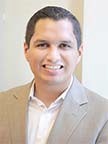Memories of College Activism in an Undocumented Student Support Group
Matias N. Ramos
Tufts University
Author Note
Matias N. Ramos, Talloires Network, Jonathan M. Tisch College of Civic Life, Tufts University.
Correspondence regarding this article should be addressed to Matias N. Ramos, Communications Coordinator, Talloires Network, Jonathan M. Tisch College of Civic Life, Tufts University, Lincoln Filene Hall, Tufts University, Medford, MA 02155. Email: matias.ramos@tufts.edu
Abstract
In this reflection, the author—a communications officer for an international coalition of universities striving to serve the public through civic engagement— shares a personal story about undocumented student activism in the college arena. An undocumented student at the time, the author describes his first encounter with other activists, their impact on his leadership development, and how students around the country took part in a movement that led to executive changes to federal immigration policy.
Keywords: civic engagement, activism, immigration, undocumented students, global citizenship
I first visited my college campus in 2004, just weeks before my high school graduation. A friend had invited me to accompany her to the University of California Los Angeles (UCLA), as she needed to do some research in the library there. As she settled into her work, I roamed around the campus imagining what it would feel like to be a college student there in a few short months. I was surprised to have been accepted, since I had only lived in the United States for five years, and I was deeply concerned about my undocumented immigrant status prior to enrolling. Following the advice of those who had said amnesty was eminent, my family and I had overstayed our permission to be in the country. Would I be able to afford a college education without financial aid? Would I face discrimination if anyone found out about my status? To my surprise, I learned quickly that I would not be alone in that struggle.
When my friend and I visited UCLA, the student newspaper’s lead story was about a rally that had taken place the day before (Bishop & Proctor, 2004). Students had staged a mock graduation to highlight the importance of access to legal status and higher education for unauthorized students. This was my introduction to student activism at UCLA. Weeks later, I would learn about the existence of a student organization called Improving Dreams, Equality, Access, and Success (IDEAS), which has supported and advocated for undocumented UCLA students since 2003. Only two years earlier, California law had established that students in the state without legal status would not have to pay burdensome international student fees if they had attended a local high school.
Most members of IDEAS were undocumented and only a few years older than I, with many experiences to share with a bright-eyed 18-year-old like myself. Over the next four years, I would become a member and learn to be a leader within IDEAS. No academic course or extracurricular activity would impact my college experience more than this group, which shaped my view of the world and encouraged me to be a civic participant. During my first year, I had just enough money to cover tuition, thanks to support from my parents, a few small scholarships, and income from a fast-food restaurant job. IDEAS helped me to navigate the campus bureaucracy and provided a support system in which I felt that others shared my experience.
Toward the end of that first year, I received news that would radically change my time in college: I had earned a full scholarship that would cover the rest of my college expenses. I no longer had to work full-time while also carrying a full course load. For me, this meant a full-time dedication to advocacy and activism— on campus and beyond.
A legal citizen is an official member of a nation-state. Active citizenship, on the other hand, “encompasses ideas as varied as civic engagement, political activism, a sense of belonging, cultural commonality, community, patriotism, virtue, and critical consciousness” (Hilton, 2015). Most IDEAS members have no recourse to legal citizenship since it is particularly difficult to adjust the status of those who came across the border without inspection or arrived from a country with the designation of “temporary protected status” (Bergeron & Messick, 2014).
During my time at UCLA, undocumented students on campus (and around the U.S.) practiced active citizenship. Political activism included acting as either outside agitators or electoral organizers. Friendly politicians received support in the form of door-knocking or phone-banking, while antagonistic politicians were confronted directly or opposed electorally. In one instance, I had the opportunity to meet then-governor Arnold Schwarzenegger along with two other undocumented UCLA students. He seemed sympathetic to our cause and told us to continue working hard on our education. Yet, such words were nothing more than lip service, as he repeatedly vetoed versions of different bills that would have assisted immigrants in their aspirations to receive a college education.
By 2006, the immigration debate in the U.S. had reached a fever pitch. The movement peaked under a peculiar set of conditions that involved political leaders in Congress and the emergent Spanish-language media. An enforcement-only bill had been approved by the House of Representatives in December 2005 and awaited a Senate debate. If passed, the legislation would have made it a crime (on par with “aiding and abetting”) for priests, social workers, and other public servants to assist or “shelter” undocumented immigrants.
My student activist peers and I were attentive to these legislative developments and participated in what the Los Angeles Times called “the biggest protests California has ever seen” (Gerson, 2016). The number of participants that day—May 1, 2006—eclipsed the number of protesters at any single demonstration against the Vietnam War. Morning radio DJs called into each other’s radio shows to show solidarity and invited listeners to participate. One commentator noted that “without the participation of the radio hosts with the largest audiences in Los Angeles at the time, maybe hundreds of thousands would not have joined the protests” (Alvarado, 2016). High school students played an important role in the protests as well, walking out of school multiple times before the ultimate May 1st mobilization (Avila & Olivo, 2006). The “Day Without Immigrants” brought people to the streets, but not everybody was together; two different marches took place within city limits. It was one of my first indications that the immigrant rights movement is one that consists of many widely different, and often divided, factions. After the failure of comprehensive immigration reform in 2006 and 2007,
the DREAM Act became a priority for many in the movement. This bill, which ultimately died by filibuster in the Senate, would have created a pathway to citizenship for those undocumented immigrants who had entered the country before the age of 16 and met other qualification criteria. The moniker “Dreamers” was appended to this campaign and remains an identifier for this generation of young political activists.
Despite advances in immigration reform, lack of legal status continues to pose a barrier to individuals’ ability to fully engage in the political process in American society (Gonzalez, 2015). Fear of legal prosecution, stigma about activism, and economic risks are considerations that undocumented youth must keep in mind as they decide to what extent they wish to become involved in political participation. For me and others, making a difference through our privileged status as college-goers became an imperative. The urgency of the political climate led me to drift away from my original Spanish and communications studies majors, and choose to concentrate in political science.
Through our time as student activists, faculty and staff provided important support for our cause. With the rise of ethnic studies and multiculturalism, the academy has become a place where important discussions are taking place regarding the effects that inequality, racism, and political disenfranchisement have on society. The field of labor studies was of particular importance to our development, as it situated our legal situation as part of a centuries-long struggle for workers’ rights and the economic policies that influenced them. Its curriculum promoted service-learning and university civic engagement. Educational conferences, high school classroom presentations, and mentoring exercises became part of our learning process and path to graduation. Student government leaders also offered support through fundraising and public statements.
However, there were factors that discouraged civic participation by undocumented students. The fear of legal repercussions cannot be overstated. Parents, for example, often discouraged students from placing themselves at risk by revealing their status publicly. Opposing parties argued that students’ lack of legal status should disqualify them from attending public universities. California was unlike many other states that took proactive measures to prevent undocumented students from enrolling. Georgia, for instance, implemented the most restrictive policies against undocumented students, denying their enrollment under all circumstances (Quinton, 2013).
University civic engagement programs that seek to integrate and empower immigrants and refugees are not exclusive to the United States. Around the world, students are taking initiative to serve marginalized populations. Our undocumented student support and advocacy group might seem unique in that it followed a particular set of events that made the population of undocumented students on campus grow. Yet, internationally, programs that serve and integrate refugees and immigrants are often based on relationships between students with legal citizenship and immigrant populations outside the university.
Through my more recent involvement with the Talloires Network—a global coalition of community-engaged universities headquartered at Tufts University (http://talloiresnetwork.tufts.edu)—I have witnessed the important rise of a movement for civic engagement and social responsibility in higher education. My current post allows me to interact with and learn from university faculty, staff, and students seeking to harness their respective university’s influence and resources to impact their surroundings in a positive way. In regions around the world, universities are working to address the important need for immigrant integration. For example, the “New Village Community Project” at the Universiti Tunku Abdul Rahman in Malaysia mentors and develops leaders among Chinese immigrants. Additionally, the Center for Civic Engagement and Community Service at the American University of Beirut has become a key resource for the rising migrant populations in Lebanon. Universities also serve the general public by aiding migrants in language acquisition and by providing accommodations for speakers of foreign languages. For instance, the University of Manchester in the United Kingdom, Canada’s Simon Fraser University, and the University of Manitoba have established multilingual programs that seek to increase cooperation between speakers of different languages and access to higher education for immigrant youth. At Duke University in the U.S., Arabic students mentor and tutor students who come from Arabic-speaking households.
Higher education is an ideal arena for creating transformative experiences for both students and surrounding communities in an increasingly multicultural world. Class discussions, student organizations, and other engagement opportunities at UCLA served as laboratories in which ideas could be put into action. From the symbolic reclamation of “undocumented and unafraid” to the marches and pilgrimages across the country, our young movement has relied on tactics and strategies that continue to create moral dilemmas. I say “young” with a clear expectation that civic involvement by undocumented or formerly undocumented youth is likely to rise over the next few years.
Nonviolent intervention methods such as sit-ins, pray-ins, and guerrilla theater events have taken place and, at times, disrupted the operations of government offices or agencies. The run-up to the 2012 “Deferred Action for Childhood Arrivals” (DACA)1 directive came at a time of great internal turmoil within the Obama administration after activists had chosen its reelection campaign offices as the target of their demands for executive action (Ingold, 2012).
Noncooperation with deportation as well as the refusal of assistance from immigration agents are the most prevalent forms of political defiance. Campaigns to keep young people in the country have been critical to the movement’s growth (including myself, as I successfully avoided deportation in 2010). Throughout its existence, the immigrant rights movement has never deviated from nonviolent principles. It has maintained discipline—first out of necessity and then by deciding deliberately to follow the principles of previously successful movements for social change.
However, the DACA victory put a damper on activism. Community organizations shifted their focus toward helping immigrants navigate the newly created system to access legal work authorization. With a gridlocked Congress and the looming 2016 presidential election, protests and actions have waned.
All of this activism has operated in nebulous legal grounds, as some would consider undocumented status as a disqualifying factor in terms of engaging in civic and political advocacy. Nonetheless, undocumented students are making their presence felt on more college campuses—and not just through the immigration issue. “Many Dreamers are as politically active as ever but are no longer bound within the categorical and organizational limits of the past” since they have integrated the plight of the undocumented into the broader modern American social justice movement (Fiorito & Nicholls 2015).
College campuses will continue to be a key battleground of ideas as this push for access to higher education and citizen status continues—in the United States and around the world.
1 The Department of Homeland Security defines this directive as “discretionary determination to defer removal action of an individual as an act of prosecutorial discretion. Deferred action does not confer lawful status upon an individual” (https://www.dhs.gov/deferred-action-childhood- arrivals)
References
Alvarado, I. (2016, March 25). División, futbol y apatía minaron las marchas proinmigrantes. La Opinión. Retrieved from http://www.laopinion.com/2016/03/25/division-futbol-y-apatia-minaron- las-marcha-proinmigrantes
Avila, O., & Olivo, A. (2006, March 11). Thousands march to Loop for immigrants’ rights: Workers, students unite in opposition to toughening of law. Chicago Tribune. Retrieved from http://articles.chicagotribune.com/2006-03- 11/news/0603110130_1_immigration-debate-pro-immigrant-illegal- immigrants
Bergeron, C., & Messick, M. (2014). Temporary protected status in the United States: A grant of humanitarian relief that is less than permanent. Migration Policy Institute. Retrieved from http://www.migrationpolicy.org/article/temporary-protected-status-united- states-grant-humanitarian-relief-less-permanent
Bishop, S., & Proctor, C. (2004, June 2). Dream Act rally held. Daily Bruin. Retrieved from http://dailybruin.com/2004/06/02/dream-act-rally-held/
Fiorito, T., & Nicholls, W. (2015). Dreamers unbound: Immigrant youth mobilizing. New Labor Forum, 24(1), 86-92.
Gerson, D. (2016, April 27). Were you part of the biggest protest LA has even seen? Los Angeles Times. Retrieved from http://www.latimes.com/local/la-me-immigration-2006-protests- 20160426-html-htmlstory.html
Gonzalez, R. (2015). Lives in limbo: Undocumented and coming of age in America. Berkeley: University of California Press.
Hilton, K. A. (2015). Undocumented citizens: The civic engagement of activist immigrants. Education, Citizenship, and Social Justice, 10(2), 1-16.
Ingold, J. (2012, June 5). Immigration activists stage sit-in at Denver Obama office. Denver Post. Retrieved from http://www.denverpost.com/ci_20791243/immigration-activists-stage-sit- at-denver-obama-office
Quinton, S. (2013, December 17). Pathways to nowhere for Georgia’s undocumented. The Atlantic. Retrieved from http://www.theatlantic.com/politics/archive/2013/12/pathways-to- nowhere-for-georgias-undocumented/430479/
Author Biography
 Matias Ramos is a writer and activist based in Boston. He works at the Talloires Network secretariat in Tufts University since 2014. He graduated from the University of California Los Angeles (UCLA) with a Bachelor’s degree in Political Science. Prior to joining Tufts, Matias worked for the Services Employees International Union, the Institute for Policy Studies, the National Immigration Law Center, and the UCLA Labor Center. He was a co- founder of a national immigrant youth advocacy network, United We Dream. Matias is originally from Argentina.
Matias Ramos is a writer and activist based in Boston. He works at the Talloires Network secretariat in Tufts University since 2014. He graduated from the University of California Los Angeles (UCLA) with a Bachelor’s degree in Political Science. Prior to joining Tufts, Matias worked for the Services Employees International Union, the Institute for Policy Studies, the National Immigration Law Center, and the UCLA Labor Center. He was a co- founder of a national immigrant youth advocacy network, United We Dream. Matias is originally from Argentina.


